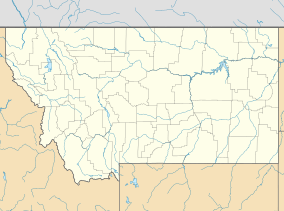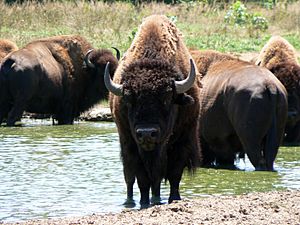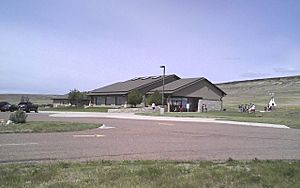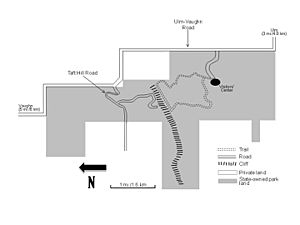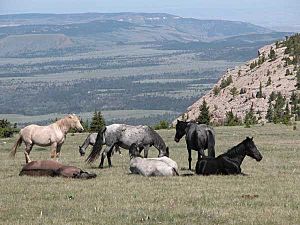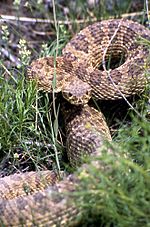First Peoples Buffalo Jump State Park facts for kids
Quick facts for kids First Peoples Buffalo JumpState Park |
|
|---|---|
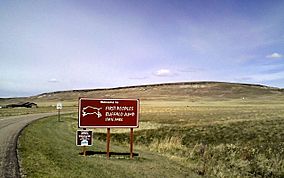
First People's Buffalo Jump State Park, buffalo jump and visitor center
|
|
| Location | Cascade County, Montana, United States |
| Nearest city | Great Falls, Montana |
| Area | 1,481 acres (5.99 km2) |
| Elevation | 3,773 ft (1,150 m) |
| Designation | Montana state park |
| Established | 1972 |
| Named for | A buffalo jump and the First Peoples of Montana |
| Visitors | 20,280 (in 2016) |
| Administrator | Montana Fish, Wildlife & Parks |
| Website | First Peoples Buffalo Jump State Park |
First Peoples Buffalo Jump State Park is a special place in Montana. It's a state park and a National Historic Landmark. This park is in Cascade County, near the city of Great Falls.
The park covers about 1,481 acres and sits high up at 3,773 feet. It's home to the Ulm Pishkun, also called the Ulm Buffalo Jump. This is a historic spot where Native American tribes used to hunt buffalo.
Many people believe it's one of the biggest buffalo jumps in North America, or even the world! It was added to the National Register of Historic Places in 1974. Then, in 2015, it became a National Historic Landmark. The name "Pishkun" comes from a Blackfeet word meaning "deep kettle of blood."
Montana has over 300 buffalo kill sites. But First Peoples Buffalo Jump is one of only three protected ones. The others are Madison Buffalo Jump and Wahkpa Chu'gn.
Contents
History of the Buffalo Jump
How Native Americans Used the Jump
The cliff at the park is about 1 mile long. It is between 30 and 50 feet high. This cliff is made of sandstone rock.
Archaeologists have found signs that Native Americans used this site as early as 500 CE. That's about 1,500 years ago! In 2011, they found a spearhead that might be 5,000 years old. This would mean people used the jump much earlier than thought. However, most evidence shows it was used a lot starting around 900 CE.
A "buffalo jump" was a clever way to hunt. Hunters would guide a herd of bison over a cliff. Before the 1700s, Native Americans did not have horses. They used dogs to help them hunt and travel. This time is often called the "Dog Days." Bison were a very important food source. But hunting them was hard because bison are big and can be dangerous.
Buffalo jumps allowed hunters to kill many animals at once. This was safer than hunting them up close. After the bison fell, hunters would kill any that survived. Then, they would use the meat, hides, and bones. They used these for food, clothing, and tools. Jumps were not common; ambushing was more typical. Some evidence suggests jumps were used from fall to spring. But finding young calf bones means they might have been used all year.
Hunters would slowly gather a bison herd. They would gently move them towards the cliff. We don't know how many hunters were needed. It could have been anywhere from 12 to 100 people. They built low fences of rock and braided vines. These "drive lines" helped guide the bison. These fences stretched for at least half a mile. Today, you can still see about 260 stone piles from these fences.
As the bison moved closer, hunters would jump out. They might have worn wolf hides. They would make loud noises to scare the herd. This would cause the bison to stampede over the cliff. Some tribes have stories about "buffalo runners." These brave young men would wear buffalo robes. They would run ahead of the herd to lead them to the cliff. The runner would then jump onto a hidden ledge below. The herd would then fall past him. Other people, often women and children, would kill any bison that survived the fall. Then, they would butcher all the animals.
The way they butchered the animals changed over time. Early hunters just took the hides and meat. But around 500 CE, they started using fire pits. They would cook or dry the meat. Then, they would grind it up and mix it with dried berries and fat. This made a food called pemmican. They also made "blood kettles." These were shallow bowls lined with rocks. They used them to boil bison blood. This made it thicker and last longer. They would mix it with other foods or ground grain.
People worked together to plan these hunts. They also worked together to butcher the animals. This teamwork was very important. But once the hunt was over, they went back to their usual ways.
Many Native American tribes have stories about First Peoples Buffalo Jump. These include the A'aninin, Assiniboine, Cree, Kalispel, Piegan Blackfeet, Salish, and Shoshoni tribes. Each tribe has its own name for this special place.
The site was used a lot for a long time. The bone bed along the cliff is 13 feet deep! Experts think at least 6,000 bison died there. When horses arrived around 1700 CE, Native Americans started hunting from horseback. So, the buffalo jump was used less and less.
After Native American Use
The area became part of the United States in 1864. In 1878, William H. Ulm, a settler, took control of the land. He had a cattle ranch there. The buffalo jump itself was called Taft Hill.
The site became popular for people looking for Native American artifacts. From 1889 to 1905, parts of the cliff were used as a sandstone quarry. Some buildings in Great Falls were built with this stone.
Later, the state of Montana owned the site. From 1945 to 1947, there was a high demand for phosphorus. This mineral is used in fertilizer. The state leased the site to a company. They "mined" the bones from the jump. Over 150 tons of bones were removed. They were ground up and used for fertilizer. This was one of the two largest sites mined for bison bone. In the 1950s, another attempt was made to mine bones. But a local rancher, Earl Monroe, leased the land to protect it.
Becoming a State Park
The state of Montana bought some of the land in the 1930s. It became part of the school trust lands. These lands are managed to help Montana's public schools. In the 1950s and 1960s, amateur archaeologists studied the site. They found out how important it was. People tried to make it a state park, but it didn't happen right away.
In the early 1970s, the Montana Historical Society leased the state'owned part of the site. In 1972, it became a Montana State Historical Monument. For many years, there were only picnic tables and signs. Local groups helped to take care of the site. Scientists also did research there in the 1990s.
The park grew a lot in the late 1990s. In 1996, the state made a land deal. This deal helped expand the park. The Montana FWP wanted to build a visitor center. Native American tribes did not want it on top of the cliffs. So, a 6,000 square foot center was built at the base of the hill.
Many improvements happened in 1999. The road to the park was widened and paved. The $2.2 million visitor center opened in May 1999. It was the first of its kind in Montana. The FWP also got more land. This allowed them to build hiking trails to the cliff summit.
In February 2000, the site became a state park. It was named Ulm Pishkun Buffalo Jump State Park. The same year, the All Nations Pishkun Association (ANPA) was formed. This group of Native American tribes helps support the park.
The park continued to grow in 2001. The state traded land to connect all parts of the jump. This also meant the park owned almost the entire cliff. A field near the visitor center was replanted with native grass. Trails about 2 miles long were built.
By 2002, the park was close to its current size. The FWP leased more land, doubling the park's size. Two private land leases were also given to the FWP. This included the last unprotected part of the hill leading to the cliff.
More educational activities were added. In 2004, the ANPA and FWP brought four Spanish Barb horses to the park. These horses are descendants of those brought by the Spanish in the 1500s.
Efforts to expand the park continued in 2005. The FWP improved Taft Hill Road. Park officials also became concerned about black-tailed prairie dogs. These animals were digging up artifacts and changing the look of the jump. They were also damaging tipi rings and sweat lodges. In 2005, new "blood kettles" were found near an old trail.
The park's expansion continued in 2006. The Montana Land Board bought 898 acres of private land next to the park. A third of this land was given to the park. This land included parts of the cliff and bone bed that had never been disturbed. Stone "drive lines" and tipi rings were also found there. This purchase expanded the park to about 2,043 acres. In 2007, the FWP bought a permanent agreement to protect more land.
More expansion was looked into in 2009. Groups suggested using extra land for buffalo or campsites. But no action was taken on this idea.
Visiting the Park
You can enter the park from Taft Hill Road or Ulm-Vaughn Road. Ulm-Vaughn Road leads to the visitor center. A 2-mile trail goes from the visitor center to the cliff summit. Along the trail, you'll see signs about the buffalo jump. You can also see a tipi ring, which is a circle of stones where a tipi once stood. The park has drinking water, trash cans, and restrooms.
First Peoples Buffalo Jump is open all year. It's about 10 miles south of Great Falls. Take the Ulm exit from Interstate 15. Then, drive 3.5 miles on Ulm-Vaughn Road. In summer (May–October), the park is open from 8 a.m. to 6 p.m. In winter, it's open from 10 a.m. to 4 p.m. Montana residents can enter for free. Non-residents pay a small fee.
The visitor center has a main hall. It explains Native American buffalo culture and how hunts were done. There's a room with artifacts found at the site. You'll also find a gift shop and restrooms. Outside, there's a picnic area. You can see a stuffed bison family (bull, cow, and calf). There's also a life-size tipi made of buffalo hides. A 160-foot mural shows the landscape. The center also highlights the importance of bison today. You can see a buffalo nickel coin and a football helmet with a bison on it. The exhibits were updated in 2006 and 2009.
You might find artifacts like arrowheads or bone tools at the park. It is against the law to dig them up or take them. If you find something, please tell a park ranger.
Plants and Animals
Many different plants and animals live at the park. Some plants you might see are blue grama, bluebunch wheatgrass, needle-and-thread grass, and prickly pear cactus.
Animals living here include American badgers, black-tailed prairie dogs, burrowing owls, coyotes, curlews, ferruginous hawks, golden eagles, gopher snakes, gray partridges, great horned owls, larks, mice, mountain cottontails, mule deer, pheasants, porcupines, pronghorns, raccoons, racer snakes, red-tailed hawks, Richardson's ground squirrels, sharp-tailed grouse, striped skunks, Swainson's hawks, western rattlesnakes, and yellow-bellied marmots.
You can hunt with a bow and arrow in some parts of the park. But you cannot use firearms. Hunters mostly look for antelope and mule deer. Not many hunting permits are given out each year.
Be careful of prairie rattlesnakes. They live at the park. It's a good idea to wear heavy hiking boots. Watch small children closely and keep pets on a leash.
Park Events
The Native American Cultural Fair happens at the park every September. It has an art show with Native American art and clothing. You can see traditional games, songs, and buffalo hide tanning. There are also talks and demonstrations about Native American culture and stories.
Since 2000, the park has also held an atlatl contest in September. An atlatl is an ancient spear-throwing tool. People come from all over to compete in accuracy and distance. You can even learn how to make an atlatl.
In 2008, the University of Great Falls started a Buffalo Jump Fun Run. It happens every Memorial Day weekend. The event includes a 3-mile walk, a 6.25-mile run, and a half-marathon.
Images for kids


